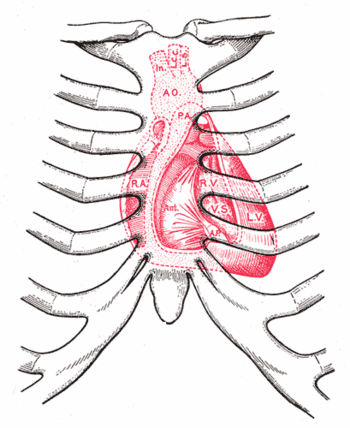Heart murmur
In medicine, heart murmurs are the "heart sounds caused by vibrations resulting from the flow of blood through the heart. Heart murmurs can be examined by heart auscultation, and analyzed by their intensity (6 grades), duration, timing (systolic, diastolic, or continuous), location, transmission, and quality (musical, vibratory, blowing, etc)."[1]
A diagram of the cardiac cycle is available and helps understand where to listen for different heart murmurs.[2]
Classification
Systolic murmurs
A systematic review by the Rational Clinical Examination addresses the diagnosis of systolic murmurs.[3]
Aortic stenosis
A clinical prediction rule may help detecting moderate to severe aortic valve stenosis (defined as a valve area of 1.2 cm2or less, or a peak instantaneous gradient of 25 mm Hg or greater):[4]
- If the murmur does not radiate to the right neck, moderate aortic stenosis was very unlikely
- If the murmur has at least three of the following signs, moderate stenosis was likely:
- slow carotid artery upstroke (other studies suggest more than 200 msec is abnormal[5])
- reduced carotid artery volume
- murmur loudest at the second right intercostal space
- reduced intensity of the second heart sound
Diastolic murmurs
Auscultation
Murmurs may be graded by their loudness:[6]
- Grade I - not heard immediately
- Grade II - heard immediately
- Grade III - hear immediately, but louder
- Grade IV - associated with palpable thrill
- Grade V - may be heard with stethoscope partially off the chest
- Grade VI - may be heard with stethoscope off the chest
References
- ↑ Anonymous (2024), Heart murmur (English). Medical Subject Headings. U.S. National Library of Medicine.
- ↑ (1990) “The First Heart Sound”, Walker HK, Hall WD, Hurst JW: Clinical methods: the history, physical, and laboratory examinations (in English), 3rd. London: Butterworths. LCC RC71 .C63. ISBN 0-409-90077-X. “See image of cardiac cycle at http://www.ncbi.nlm.nih.gov/bookshelf/br.fcgi?book=cm&partid=333&rendertype=figure&id=A684” Library of Congress
- ↑ Etchells E, Bell C, Robb K (February 1997). "Does this patient have an abnormal systolic murmur?". JAMA : the Journal of the American Medical Association 277 (7): 564–71. PMID 9032164. [e] Full text at OVID
- ↑ Etchells E, Glenns V, Shadowitz S, Bell C, Siu S (October 1998). "A bedside clinical prediction rule for detecting moderate or severe aortic stenosis". Journal of general internal medicine : official journal of the Society for Research and Education in Primary Care Internal Medicine 13 (10): 699–704. PMID 9798818. PMC 1500900. [e] PubMed Central
- ↑ Flohr KH, Weir EK, Chesler E (May 1981). "Diagnosis of aortic stenosis in older age groups using external carotid pulse recording and phonocardiography". British heart journal 45 (5): 577–82. PMID 7236464. PMC 482567. [e]
- ↑ McGee, Steven R. (2007). “Heart Murmurs: General Principles”, Evidence-Based Physical Diagnosis. Philadelphia: Saunders, 456. ISBN 1-4160-2898-6.
Bibliography
- Drummond Rennie; David Simel (2008). THE RATIONAL CLINICAL EXAMINATION: EVIDENCE-BASED CLINICAL DIAGNOSIS (Jama & Archives Journals). McGraw-Hill Professional. ISBN 0-07-159030-7.
- McGee, Steven R. (2007). Evidence-Based Physical Diagnosis. Philadelphia: Saunders. ISBN 1-4160-2898-6.
- (1990) Walker HK, Hall WD, Hurst JW: Clinical methods: the history, physical, and laboratory examinations (in English), 3rd. London: Butterworths. LCC RC71 .C63. ISBN 0-409-90077-X. Library of Congress
